How to prune trees correctly: types, types and pruning technology
Fruit and ornamental trees need periodic pruning... Nobody argues about this anymore, since its necessity has long been proven to increase fruiting or give the crown the desired shape. A well-kept garden is not only beautiful, but also effective.
Trees bring a good harvest of apples, pears, and decorative plantings take on an elegant look. Everyone can learn how to do the correct pruning, but for this you should carefully study this issue. Understand the biological processes of plants. Without this knowledge, you can harm the tree, not help. The gardener needs to understand what kind of pruning is best done and whether it is needed at all. Let's try to figure out how to properly prune trees.
Content:
- Types and types of tree pruning
- Autumn pruning
- Spring pruning
- Trimming technology and tools
- Why you need to prune trees
Types and types of tree pruning
On the Internet, in many sources for pruning trees, you can find all sorts of information regarding types of pruning. All of them are different and introduce the novice gardener into some doubt and confusion. For a clear understanding of the process, we will be guided by the classification adopted officially and on the basis of which the pruning masters and dendrologists act. Allocate:
- Form trimming. It is designed to create a specific crown shape, control the height of the tree, fruiting and flowering, enhancing the growth of shoots. With the help of this type, the degree of crown density is regulated. Trees are usually given a spherical, pyramidal, conical, or oval shape. Make sure your trees can handle the procedure well before doing form pruning. You should also take into account the age of the plants and the type of natural crown shape. Typically, this type of pruning is applied to ornamental trees such as conifers. Pruning is carried out in early spring, in March. Fast growing trees form every year. Those that develop slowly, once every two years, can be less often.
- Sanitary. This pruning involves removing dry branches and shoots growing at an acute angle or vertical to the main trunk. Such shoots grow over time and become almost the same size as the main trunk. In a gust of wind, for example, they can break and cause irreparable damage to the entire plant system. Therefore, they are cut out. The procedure must be carried out annually. As a result, the tree does not waste energy on maintaining unnecessary shoots, tops and dry branches. The crown is thinned out, which promotes better aeration. Often trees that have suffered from low winter temperatures need such pruning.
- Anti-aging. Rejuvenating pruning is done to reanimate old trees when they do not grow annually. Usually, plants that have reached 25-30 years of age need such radical pruning. The crown and most of the branches of the tree are already dry. When pruning, remove all leading trunks, main and leaders. The procedure is carried out over several years, and not immediately. First, the upper branches and trunks are shortened by 2-3 meters. The next year, lateral, overgrown shoots.Only in the third year can you see the result of rejuvenating pruning - shortened skeletal branches and the absence of all dry shoots. After the procedure, the tree needs several years to recover. Along with anti-aging pruning, the same procedure is carried out for root system... To do this, at a distance of 3-4 meters from the trunk, a trench about 70x70 cm in size is dug out.The thick roots are chopped off, after which the trench is covered with fertile soil with the addition of mineral and organic fertilizers... The tree is watered abundantly.
Below is a list of trees that will tolerate any type of pruning well. But this does not mean that you can remove everything from these plant species. These trees recover well after the procedures and grow back quickly. The following plants are distinguished that lend themselves well to pruning:
Birch, Rowan, bird cherry, nut, maple, Pine and fir - these types of plants do not tolerate pruning well. Therefore, carry it out very carefully so that there are as few slices as possible annually. You need to give the trees the opportunity to recuperate.
In addition to the types of pruning, its intensity is also distinguished: weak, medium or strong.
The first and second are used in the case of pruning old trees. This is due to the fact that the plant heals slowly, as sap flow slows down with age. Heavy pruning is applied primarily to young trees or seedlings. The upper shoots are pinched by 2-3 buds in order to uniformly form the crown and control the height of the tree. Many gardeners argue about the appropriate time frame for pruning. Someone insists on spring, while others do it in autumn. Let's deal with autumn and spring pruning.
Autumn pruning
Only those trees in which intensive sap flow occurs in the spring are subject to autumn pruning. This category of plants includes birch, alder and maple... Everyone knows that the birch is the first to wake up. This is due to the early movement of the juice. Also, conifers are cut in the fall - thuja, Pine, fir, spruce. These plants differ from the rest by the release of resin, which has bactericidal properties. After pruning, wounds heal well, they do not even need to be treated with anything.
In summer or autumn, you can carry out any type of pruning, more often it is sanitary or molding.
Old trees rejuvenate. A common procedure for the grower is to prune dry branches, spinning tops, or shoots that are facing sideways or downward. Branches directed inward and intertwined with each other are removed. Be guided by the main rule - the branch that needs to be cut off, take it to a strong shoot. That is, you can't just grab and delete a branch. We need to see what kind of escape will replace her in the future.
Do not forget that the sanitary type of pruning can be carried out at any time and every year - removing dry knots, unnecessary tops, "thorns" growing on the trunk and diseased shoots.
Spring pruning
All trees with moderate sap flow are subject to spring pruning. These include apple trees, pears, willow, poplar. Dendrologists recommend starting pruning in March or April. In the spring, you can see very clearly which branches and shoots are to be shortened or pruned per ring. Dry, frozen shoots are removed, those that grow at an acute angle or vertically to the trunk are shortened. If you see that along with the main trunk a shoot is developing, which begins to compete with it, remove it.
Such a phenomenon should not be allowed when lateral shoots take leadership from the main trunk.
Usually many gardeners make this mistake. If you had to cut a rather thick branch, the wound must be treated with garden varnish. This rule does not apply only to conifers. Always make sure that the cuts are straight, without nicks or sharp corners. Moisture accumulates in the pits and there is a risk of fungal diseases.Instrumentation must be clean, dry and sharp.
Having dealt with the timing of pruning, let's look at the technology for forming crowns, as well as the types of tools with which it is carried out.
Trimming technology and tools
Regardless of what kind of pruning needs to be done, its technology comes down to ways to remove branches. There are the following slice methods:
- On the kidney it is used for shortening young shoots, usually weak and unnecessary. They are cut over a strong kidney so as not to hurt it. The cut starts at the level of the base of the kidney, but on the other side and ends at the level of its apex. You cannot cut below or above the base of the bud, and also leave the branch much higher than its top. This can cause the shoot to dry out. That is, there will be no sense from such a trim.
- Dry branches or those that interfere with the normal development of the main trunk and strong shoots are brought out to the ring. The branch is carefully filed from below along the growth of the growth of the base of the branch to about the middle of the diameter. Then the cut is made from above. The result is an even cut flush with the trunk. An error when sawing into a ring is a very deep cut, going deeper into the trunk or the remaining stump. You cannot cut a branch only from the top. The main cut is made from below, at the base of the branch outgrowth.
- Another way to remove branches is a triple notch. It is done only if you are dealing with a large and fat bitch. In order to avoid the breakage of the bark and uneven sawing, the branch is cut in three places. So there is no threat of breaking and pulling the mother's bark from the trunk.
Special tools are used to prune trees. Do not use carpentry tools or ordinary knives. Apply:
- Different types of garden pruners (straight or wrap).
- Garden shears (cutting and chopping).
- Loppers and garden knives.
- Garden saws (electric, hand-held, chainsaws).
- Choppers.
Whatever tool you use, it must be clean, dry and sharp. When pruning diseased shoots, be sure to disinfect the tool after each cut so as not to transfer the infection to healthy shoots. Choose a tool that is suitable for pruning one or another type of branch - twigs, trunks, shoots, tops or "pins".
Observe safety guidelines when cutting tall trees.
Tie heavy branches so that they do not fall on nearby plants or people. Hire another person to help you out. The stepladder for work at height must be strong and not fall apart on the move. Be careful when cutting the upper branches. Before climbing up, study the crown and mark the cuts. Try to determine where the heavy branch is likely to fall.
Why you need to prune trees
Benefits trimming obvious. With its help, they regulate the growth of the plant, the degree of thickening of the crown and fruiting. It helps to keep the tree in good condition. For example, small sanitary pruning prevents crown thickening. That is, as a result, normal aeration occurs, the risk of fungal diseases is reduced to zero. Fruit trees begin to bear fruit better, apples or pears become larger and juicier. Pruning helps to maintain the most valuable thing - the health of the tree.
Prune trees to keep your garden in good condition and to get a good harvest.
Don't be lazy and take care of green pets. As you gain experience, tree pruning will intimidate you less and less. Study the trees, plan pruning schemes and get down to business. You will definitely succeed!
More information can be found in the video:




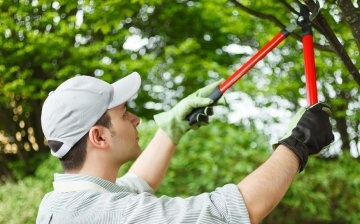
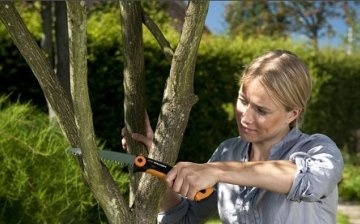

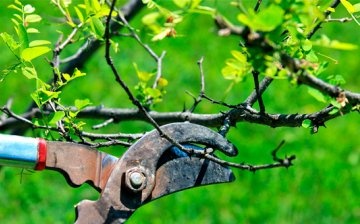
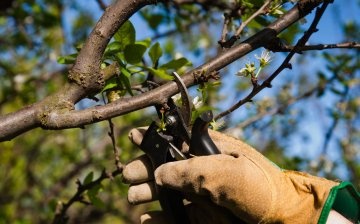









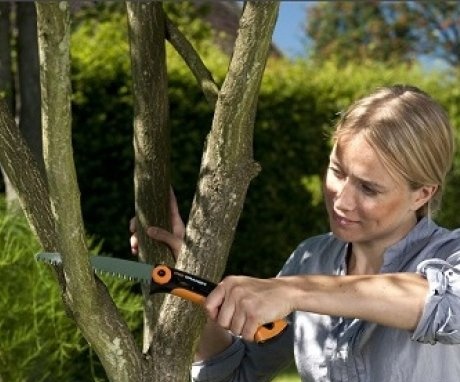

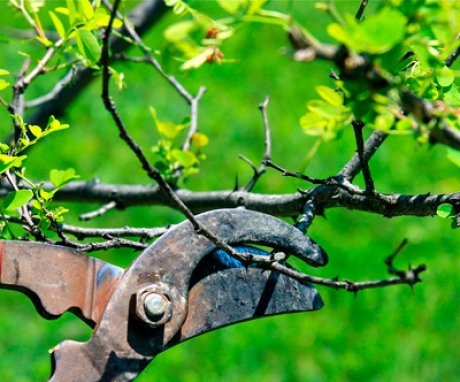
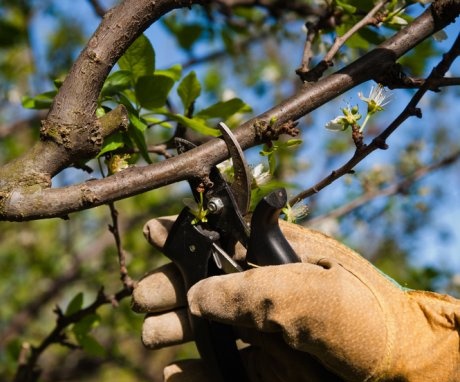

I cut off the branches that go into the crown of the tree with a pruner. In addition, branches that are long, and, moreover, they do not have lateral shoots. I do not delete thick branches, because.I manage to cut the branches while they are still thin.